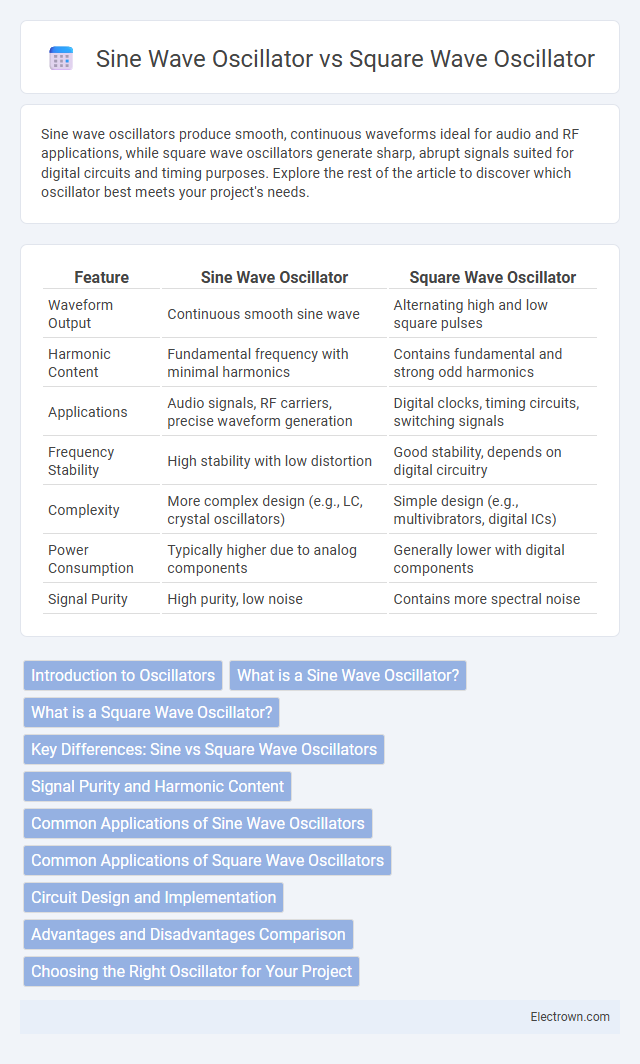Sine wave oscillators produce smooth, continuous waveforms ideal for audio and RF applications, while square wave oscillators generate sharp, abrupt signals suited for digital circuits and timing purposes. Explore the rest of the article to discover which oscillator best meets your project's needs.
Table of Comparison
| Feature | Sine Wave Oscillator | Square Wave Oscillator |
|---|---|---|
| Waveform Output | Continuous smooth sine wave | Alternating high and low square pulses |
| Harmonic Content | Fundamental frequency with minimal harmonics | Contains fundamental and strong odd harmonics |
| Applications | Audio signals, RF carriers, precise waveform generation | Digital clocks, timing circuits, switching signals |
| Frequency Stability | High stability with low distortion | Good stability, depends on digital circuitry |
| Complexity | More complex design (e.g., LC, crystal oscillators) | Simple design (e.g., multivibrators, digital ICs) |
| Power Consumption | Typically higher due to analog components | Generally lower with digital components |
| Signal Purity | High purity, low noise | Contains more spectral noise |
Introduction to Oscillators
Oscillators generate periodic waveforms essential for electronics, with sine wave oscillators producing smooth, continuous signals ideal for audio and radio frequencies. Square wave oscillators create abrupt, digital-like waveforms commonly used in digital clocks and switching circuits. Your choice between these oscillators impacts signal purity, harmonic content, and application suitability.
What is a Sine Wave Oscillator?
A sine wave oscillator generates a smooth, continuous waveform characterized by a single frequency with no harmonics, making it ideal for applications requiring pure tones such as audio testing and signal processing. Unlike square wave oscillators that produce a waveform with abrupt transitions and rich harmonics, sine wave oscillators provide a clean, distortion-free output crucial for precision in communication systems. Your choice between these oscillators depends on the need for either harmonic simplicity or complex waveform generation in electronic circuits.
What is a Square Wave Oscillator?
A square wave oscillator generates a periodic waveform that switches abruptly between high and low voltage levels, producing a signal with a 50% duty cycle and sharp transitions. It is widely used in digital circuits, pulse width modulation, and clock generation due to its precise timing characteristics and harmonic-rich waveform. Unlike sine wave oscillators, square wave oscillators create signals with rapid changes that produce strong odd harmonics, essential for digital signal processing and switching applications.
Key Differences: Sine vs Square Wave Oscillators
Sine wave oscillators generate smooth, continuous waveforms ideal for audio and radio frequency applications, producing minimal harmonic distortion. Square wave oscillators output a waveform with abrupt transitions between high and low states, making them suitable for digital circuits and timing signals due to their rich harmonic content. The fundamental difference lies in waveform shape, spectral purity, and typical usage in analog versus digital systems.
Signal Purity and Harmonic Content
Sine wave oscillators produce signals with high purity, characterized by a single fundamental frequency and minimal harmonic distortion, making them ideal for applications requiring clean audio or RF signals. Square wave oscillators generate signals rich in harmonic content, consisting of odd harmonics that contribute to their distinctive, sharply defined waveform but can introduce noise in sensitive circuits. Your choice between these oscillators depends on the need for signal purity versus harmonic richness, impacting performance in audio synthesis, communication systems, and testing equipment.
Common Applications of Sine Wave Oscillators
Sine wave oscillators are widely used in audio signal generation, communication systems, and function generators due to their smooth, continuous waveform that produces minimal harmonic distortion. These oscillators are essential in applications like radio transmitters, test equipment calibration, and waveform synthesis where precise and stable frequency output is critical. Unlike square wave oscillators, sine wave oscillators offer cleaner signals ideal for analog circuitry and high-fidelity audio processing.
Common Applications of Square Wave Oscillators
Square wave oscillators are commonly used in digital electronics for clock generation, timing circuits, and pulse width modulation due to their fast switching characteristics. They serve as signal sources in microcontrollers and digital signal processors, enabling precise timing control in communication systems. Another key application is in audio synthesizers, where square waves produce distinctive tonal sounds for electronic music production.
Circuit Design and Implementation
Sine wave oscillators typically use resonant circuits such as LC tanks or crystal oscillators to produce smooth, continuous waveforms, relying on components like inductors, capacitors, and operational amplifiers for stable frequency generation. Square wave oscillators often implement digital or relaxation oscillator designs, such as multivibrators or Schmitt triggers, utilizing comparators and switching devices to achieve rapid waveform transitions. The design complexity of sine wave oscillators is higher due to harmonic purity requirements, whereas square wave circuits emphasize simplicity and sharp edge generation for applications like clock signals and digital timing.
Advantages and Disadvantages Comparison
Sine wave oscillators generate smooth, continuous signals ideal for audio and RF applications, offering low harmonic distortion and clean output but are complex to design and sensitive to component variations. Square wave oscillators produce sharp, easily filtered signals with simpler circuits, making them suitable for digital timing and switching, though they generate high harmonic content that can cause electromagnetic interference. Your choice depends on required signal purity and application context, balancing design complexity against signal characteristics.
Choosing the Right Oscillator for Your Project
Sine wave oscillators produce smooth, pure tones essential for audio and communication projects requiring minimal harmonic distortion, while square wave oscillators generate sharp, digital signals suited for clock pulses and digital circuits. Selecting the right oscillator depends on your project's frequency stability needs, signal purity, and harmonic content preferences. Sine wave oscillators excel in analog signal processing, whereas square wave oscillators are ideal for timing and switching applications in microcontrollers and logic devices.
Sine wave oscillator vs square wave oscillator Infographic

 electrown.com
electrown.com